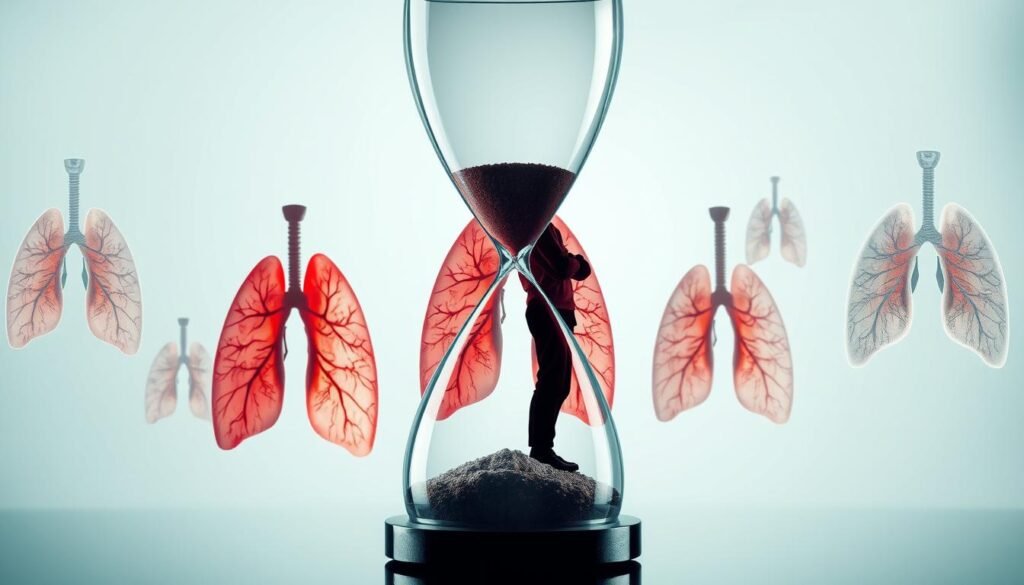About one-third of people with lung cancer are found at stage 3. This shows how important it is to know what to expect at this serious point. Looking at life expectancy without treatment for stage 3 lung cancer is key. We must think about many things that can change survival rates. The future is not clear because of a lot of reasons, such as a person’s age, their health, and the kind of lung cancer they have. The facts tell us that the average survival time for those who don’t get treatment is worrying. This makes us think more about the effects of not getting or waiting too long for treatment.
Key Takeaways
- About one-third of lung cancer patients are diagnosed at stage 3.
- Average life expectancy for untreated stage 3 lung cancer is variable based on individual circumstances.
- Age, cancer type, and overall health significantly influence untreated lung cancer prognosis.
- Survival statistics emphasize the need for timely treatment interventions.
- Understanding advanced lung cancer life expectancy is essential for informed decision-making.
Understanding Stage 3 Lung Cancer
Stage 3 lung cancer represents a critical point in the journey of those living with the disease. At this stage, tumors have often spread to nearby tissues, organs, and lymph nodes. This phase is diagnosed in about one-third of all lung cancer cases. It shows why it’s essential to comprehend the array of lung cancer treatments.
The stage has different subcategories for non-small cell lung cancer, labeled 3A, 3B, and 3C. Each category has its own unique set of characteristics and challenges to overcome.
- Stage 3A: This level might feature tumors from 5 cm to over 7 cm, several tumors in one lung, or cancer spread to areas close to the lung.
- Stage 3B: At this level, tumors may be smaller than 5 cm. However, they could have reached the lymph nodes on the chest’s opposite side or above the collarbone.
- Stage 3C: Tumors larger than 5 cm are more common here, spreading to multiple lobes or various lymph nodes in the chest.
Small cell lung cancer is split into either limited or extensive stage instead of using the standard numeric staging. Symptoms of this advanced lung cancer stage can range from persistent coughing, chest pain, and losing appetite to significant weight loss and difficulty breathing. Informing patients about stage 3 lung cancer and how to treat it is key to making sure they can decide about their care wisely.
Treatment for stage 3 non-small cell lung cancer may involve chemotherapy, radiation therapy, and sometimes surgery, depending on what the patient needs. The outlook for someone with stage 3 lung cancer depends on things like the tumor’s traits, their overall health, and how well they respond to treatment. So, knowing all you can about stage 3 lung cancer helps guide patients as they navigate their healthcare choices.
| Stage | Characteristics | Common Treatment Options |
|---|---|---|
| 3A | Tumors 5 cm to over 7 cm, multiple tumors, nearby spread | Chemotherapy, radiation, surgery |
| 3B | Tumors | Chemotherapy, radiation |
| 3C | Tumors > 5 cm, multiple lobes, spread to various lymph nodes | Combination therapies, surgery if resectable |
Classification of Lung Cancer Stages
Knowing the stages of lung cancer is crucial for its treatment and diagnosis. The TNM staging system helps by looking at tumor size, nodal involvement, and if it has spread. This is very important for both doctors and patients to understand because it influences the treatment and how likely someone is to get better.
Stage 3 lung cancer has three parts: 3A, 3B, and 3C. Each part tells us how far the cancer has spread.
- Stage 3A: Here, the cancer might have reached lymph nodes close to the trachea or bronchi. It’s usually still on one side of the chest.
- Stage 3B: This shows cancer in lymph nodes near the heart or aorta, or on the chest’s other side. It means the cancer is spreading more.
- Stage 3C: Cancer at this point might have grown into nearby areas like the chest wall. This is the most advanced stage in category 3.
Knowing about stage 3 lung cancer helps in choosing the best treatment. Options can include surgery, chemo, radiation, or targeted treatments. For more details on stage 3 lung cancer, look at this resource.
The TNM staging system is key for picking treatments and talking about the future. It’s wise for patients to discuss this system with their doctors. Check out more about the staging system here.
Factors Affecting Prognosis of Lung Cancer
The outcome of lung cancer depends on several key factors. Knowing these helps doctors create better treatment plans. It boosts survival chances. Factors like cancer type, tumor features, and patient health are essential.
There are different types of lung cancer, each affecting survival differently. For example, NSCLC and SCLC have unique survival rates. Patients under 65 tend to do better than those over 65. This shows how age influences lung cancer outcomes.
Let’s look at what impacts prognosis:
| Factor | Impact on Prognosis |
|---|---|
| Stage of Cancer | Earlier stages have better prognoses than advanced stages (e.g., stage III vs stage IV) |
| Radiotherapy Dose | Higher doses (≥60 Gy) correlated with improved survival rates |
| Type of Treatment | Concurrent chemoradiotherapy yields better survival chances than sequential treatment |
| Performance Status | Patients with better daily functioning report improved prognoses |
| Weight Changes | Weight loss over 5% before treatment leads to less favorable outcomes |
Genetic changes in cancer cells also affect treatment responses. This shows why personalized medicine is key in lung cancer care. Women tend to have a slightly better prognosis than men. Overall health matters too, especially for surgical options.
Stage 3 Lung Cancer Life Expectancy Without Treatment
It’s vital for both patients and families to grasp what stage 3 lung cancer means without treatment. For these patients, life expectancy can vary a lot. Some face a very short time. On average, people without treatment live between 5 to 12 months. Several factors affect survival times. These include the type of lung cancer and the patient’s overall health condition.
Average Life Expectancy Without Treatment
Looking at survival rates, we see some differences. Those with non-small cell lung cancer (NSCLC) tend to do slightly better than those with small cell lung cancer (SCLC). Unfortunately, 80% find out they have lung cancer when it’s already advanced. Specifically, stage 3 lung cancer patients without treatment live, on average, about 7 months.
| Lung Cancer Stage | Median Survival Time Without Treatment |
|---|---|
| Stage IIIA | 6.1 months |
| Stage IIIB | Approximately 5 months |
| Stage IIIC | Less than 5 months |
When talking about adenocarcinoma, the 5-year survival rate is 77.5% if it’s found early. However, this number goes down to 5% for advanced stages. Small cell lung cancer has a 29% survival rate when localized. This drops steeply to 3% at distant stages.
Individual Variability in Survival
Survival numbers are just averages. The real picture is more complex. Things like age, existing health conditions, and lifestyle impact survival. For example, those over 65 can expect a 54.6% survival rate if the cancer is localized. This goes down to 4.7% if the cancer spreads far. People aged 50-64 have a 67.4% survival rate for localized cancer. This lowers to 7% when it spreads.
Talking openly with healthcare providers is key. Choosing not to treat lung cancer can be for many reasons. Costs, personal beliefs, or the stress of a diagnosis influence care decisions.
Survival Rates by Lung Cancer Type
It’s key to know the differences between non-small cell lung cancer (NSCLC) and small cell lung cancer (SCLC). These differences impact survival rates, which affect prognosis and treatment plans.
Non-Small Cell Lung Cancer (NSCLC)
NSCLC is more common among lung cancers. Its survival rates differ greatly, depending on the cancer’s stage and type. For example, someone with stage 3 NSCLC might have a five-year survival rate around 35%.
Different NSCLC types have their own survival rates:
- Adenocarcinoma: 25.82 months
- Large cell carcinoma: 11-14.2 months
- Squamous cell carcinoma: 10.1-12.9 months
Modern treatments like chemotherapy and immunotherapy have helped boost NSCLC survival rates.
Small Cell Lung Cancer (SCLC)
SCLC is less common but more aggressive. It has poorer survival rates compared to NSCLC. For stage 3 SCLC, the five-year survival rate is about 16%.
Life expectancy for SCLC can be between 7 to 16 months, depending on treatment and early detection.
Survival Rates Based on Patient Age
Age is key in the survival odds for lung cancer patients. Statistics show big differences in survival chances across age groups. This points out how age impacts lung cancer survival. Younger patients often have a better chance than older ones. Knowing this can improve care and support during treatment.
Age Group Impacts on Life Expectancy
According to the SEER database, survival rates drop as people get older. Those diagnosed before 50 have much better five-year survival rates. Meanwhile, those 65 and up see a big drop in life expectancy. This is really important to consider for the older adults lung cancer prognosis.
| Age Group | 5-Year Survival Rate (%) |
|---|---|
| Under 50 | Higher than 50 |
| 50-64 | Approximately 30 |
| 65-74 | Approximately 16 |
| 75 and older | Lower than 10 |
Age greatly affects treatment success. Patients 60 and under who had chemo and surgery showed a 63% five-year survival rate. But those over 65 getting only chemoradiation had a 19% survival chance. This underlines the importance of age in lung cancer treatment choices.

Impact of Overall Health on Life Expectancy
The health of lung cancer patients strongly affects how long they live. Those with other health issues like diabetes or heart disease may struggle more with cancer treatments. These conditions can make treating cancer harder and lower chances of survival.
Research shows that patients in good health are more likely to survive longer. If they don’t have other major health problems, they tend to do better in fighting cancer. The impact of overall health on lung cancer is clear, especially in how other illnesses can interfere with cancer treatment.
How well patients can handle different treatments also matters a lot. Being active in managing health can help increase survival and improve life quality. Doing regular health checks, controlling existing conditions, and living healthy are key parts of a care plan that helps lung cancer patients.
| Overall Health Status | Impact on Cancer Survival | Co-existing Conditions |
|---|---|---|
| Good Health | Higher survival rates, better treatment outcomes | Minimal impact on treatment |
| Moderate Health Issues | Variable survival rates | May complicate treatment |
| Poor Health | Lower survival rates, limited treatment options | Significant negative impact |
It’s vital to know how overall health affects the outlook for lung cancer patients. Working on any other health problems is key to better cancer survival rates and longer life.
Palliative Care Options for Untreated Lung Cancer
Palliative care provides vital support for those with lung cancer, no matter their treatment stage. This care focuses on physical and mental symptoms, aiming for a better life quality. Teams of doctors, nurses, and social workers come together to offer personalized care for each patient.
Care options include treatments for pain, breathlessness, tiredness, and sickness. Psychological support also helps with anxiety and depression, offering emotional comfort. It’s important for patients and their families to share their worries, so care plans can be adjusted.
Some prefer receiving care at home, while others choose hospitals, clinics, or palliative centers. Hospice care, focused on end-of-life, starts when life expectancy is short. Many in hospice care see their life quality improve significantly.
Talking about end-of-life care early is key. These discussions help patients and families make well-informed choices. This way, they can adjust care plans for greater comfort and dignity in life’s final stages.

| Palliative Care Options | Details |
|---|---|
| Symptom Management | Palliative care helps relieve pain, fatigue, nausea, and other symptoms, improving daily comfort. |
| Emotional Support | Psychological services address anxiety and depression, fostering mental well-being. |
| Healthcare Team | A multidisciplinary team of doctors, nurses, and social workers collaborates for comprehensive support. |
| Care Settings | Care can be provided at home, in hospitals, clinics, or specialized palliative care centers. |
| Hospice Care | Available when life expectancy is six months or less, focusing on comfort and quality of life. |
Recognizing End-Stage Lung Cancer Symptoms
When lung cancer reaches its final stages, it’s vital for patients and their families to know the symptoms. Recognizing these signs helps in managing care effectively. It prompts important talks about future care options, like hospice.
Signs of Disease Progression
At advanced stages, patients show several symptoms. Key signs include:
- Significant weight loss: A rapid drop in weight often points to the disease’s advancement.
- Severe fatigue: Ongoing tiredness makes daily tasks hard.
- Increased cough: A worsening cough can mean airway issues or fluid in the lungs.
- Breathing difficulties: As the disease gets worse, breathing becomes hard.
- Chronic pain: Chest pain or pain in other areas may get worse, needing careful management.
Knowing these symptoms is critical. They signal the need for more support. Properly managing these symptoms can make life better and more comfortable for patients. Looking for help, including end-of-life care information, is good for patients and families in tough times.
Importance of Quality of Life in Advanced Lung Cancer
When dealing with advanced lung cancer, care shifts towards improving the lung cancer quality of life. This helps patients and their families make smart choices about treatment. Treatments are chosen based on how they affect well-being, focusing on easing symptoms, offering emotional support, and honoring personal values.
People’s treatment choices often depend on their age and health. Older patients usually want treatments that let them enjoy daily activities. They value quality of life more than living longer. Younger patients might choose tougher treatments hoping to extend their lives. They might accept the side effects. This shows how vital it is to know what each patient values in advanced cancer management.
Lung cancer stigma greatly influences patients’ quality of life. Many feel judged, leading to mental stress and worse well-being. Fighting this stigma and providing strong support networks greatly helps improve patients’ lives.
The table below shows what impacts life quality for lung cancer patients:
| Factor | Impact on Quality of Life |
|---|---|
| Physical Symptoms | Worse symptoms like pain and fatigue decrease quality of life |
| Smoking Status | Non-smokers generally report higher quality of life |
| Emotional Support | Higher levels of support correlate with better quality of life |
| Psychosocial Factors | Stigma and distress negatively influence quality of life outcomes |
| Palliative Care | Early intervention often leads to improved quality of life |
Talking about lung cancer quality of life needs teamwork among patients, families, and doctors. By focusing on what’s important to each person, cancer care can better improve life satisfaction. This brings a more balanced view to choosing treatments.

Conclusion
Understanding stage 3 lung cancer and its future without treatment is complicated. A major study looked at 99 people with stage III non-small cell lung cancer (NSCLC) that couldn’t be treated with surgery. It found big differences in survival rates based on age, gender, and overall health.
Patients with stage 3 lung cancer should not rely only on broad statistics for survival. Factors like the kind of tumor or past health issues are crucial in figuring out survival chances. The study also showed the value of a custom scoring system to help doctors give better survival estimates and improve care.
For those dealing with stage 3 lung cancer, being up-to-date on treatment options is key. The impact of choices regarding lifestyle and health on survival is also important. The study’s insights, available here, offer valuable information on prognosis and treatments. This can help make informed decisions on the journey ahead.